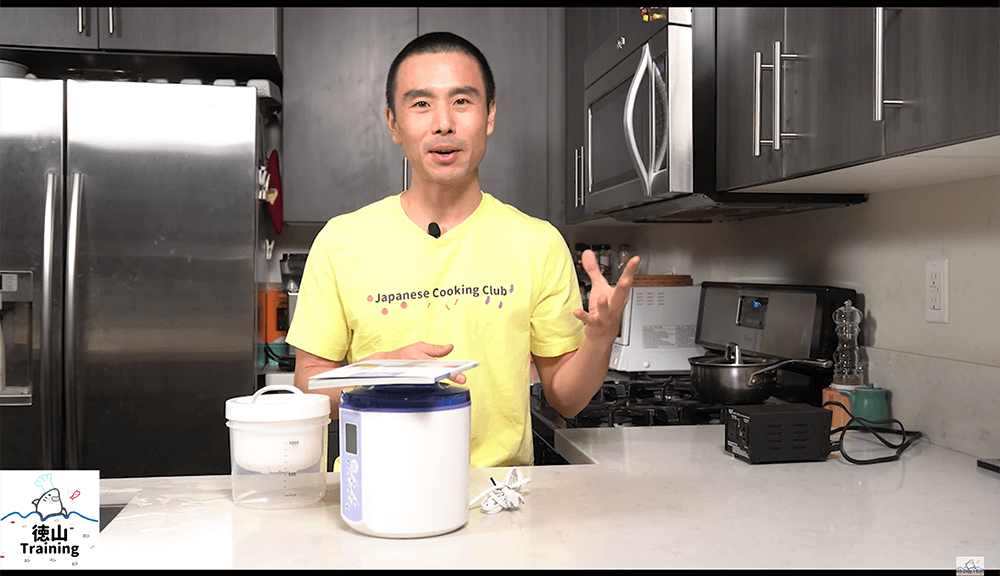Have you ever been curious about making your own homemade natto? Natto is fermented soybeans and it’s a stinky yet tasty Japanese food, if you’ve never had it before.
If not that, how about making your own amakouji? Amakouji is literally sweet kouji, and it could be used to make all kinds of things, like amazake, which is literally sweet sake.
Or if not amakouji or natto, then how about making your own cheese or yogurt?
And if you’re not interested in making any of those four options, how about onsen tamago? Onsen tamago is literally onsen, which is a hot bath egg.
You can do all five of those things using this Yogurtia yogurt machine. If you want to learn more, stay tuned and I’ll tell you all about it.
Tanica Yogurtia Yogurt Machine General impression
Today we are doing a little product review for the Yogurtia yogurt machine. This is from Japan. The manual comes in Japanese. Unless you can read Japanese, you probably won’t understand what it says but there are some beautiful pictures if you want some inspiration.

I did find an English Yogurtia Tanica instruction manual (after I recorded the video) so if you were still concerned about that here’s the download link!
Don’t worry, because I have a few video lessons that are going to show you how exactly to use this machine, so you can get some delicious Japanese foods in no time, and also be going over a few pros and cons as well.
The reason that I got this Yogurtia yogurt machine was specifically to make amakouji and natto, as well as onsen tamago. Those are the three reasons why I was looking to get one of these. There’s actually one other machine that had pretty good reviews, another best seller on Amazon Japan, but I ended up going with this one because, one, I liked the color. It’s nice and blue. And then also the functionality.
This one actually came as a set. This came with a yogurt strainer as well as a few coffee filters, which you can strain your yogurt to get like a more of a Greek-style yogurt. Then an onsen tamago set/ holder, which you can use with this as well.
Like I mentioned at the very beginning, the reason that I got this was to make amakouji and natto. I tried making homemade natto on my bread proofing machine, which is doable, but it’s a little bit more fussy because the bread proofing machine that I have, the Brod & Taylor, doesn’t feel like the natto fermented evenly as compared to the way that it did in the yogurt machine.
How to use the Yogurtia
In terms of using the Yogurtia yogurt machine, it’s pretty straightforward. There are only few buttons. The first button says start and stop in Japanese. There’s one for the temperature which is going to be in Celsius, and then the timer. There’s also a little button for the sound. There is a beeping noise that’ll go off when your thing is done.
Basically, all you gotta do is once you’re ready to make whatever it is that you’re gonna make, all you have to do is drop the container. These are all plastic containers and it comes with like a little lid, which you can latch on easily and take it in and out. Then, you set the temperature and the timer, and you’re done. You let the machine and all the little bacteria do all the work for you. So it’s pretty simple.

The size of this container is about a 1,000-mils. You could probably overfill it a little bit to maybe up to 1,200 but otherwise, these are pretty sturdy, nice and soft plastic. All these things are dishwasher-safe too.
Depending on what it is that you’re making, you may have to use the inner lid. There’s an inner lid and then an outer lid. You always want to put the outer lid on, but they fit nice and snug perfectly.
So if you’ve never used any kind of a Japanese device before, what I would recommend, like my shaved ice machine, kakigori machine, is to use a voltage regulator so that you don’t fry the machine. If you’re in the US, for example, we have 120 volts in our electrical outlets, but in Japan they use only 100. Use a voltage down regulator that you can get on Amazon as well.
I just use the regulator specifically for my yogurt -maker and kakigori machine. The kakigori machine is a shaved ice machine, which makes Japanese shaved ice and any other icy desserts. Like, if you wanted to make like granita or any kind of slushy, that’s what that machine is good for. I actually did a product review of the kakigori machine, if you want to check that as well.
CONS
There are a few pros and cons that I can share with you after using it for many different things.
1. The capacity is kind of limited.
Depending on how much yogurt you enjoy eating, 1,000 mils is probably good enough to last maybe about a week, if you are sharing this between two people and each person eats about a quarter cup to a half cup each day.
2. A second con would be that because it is plastic, you may notice that, depending on what you’re putting in here, you’re gonna have some sort of odor.
For example, when I made natto, it still kind of smells like natto. I usually just reserve the same container for the same type of thing. I have three of these that came with my set and then one is going to be for kouji, amakouji. The other one still smells a little bit like amakouji. And my other one is for yogurt or cheese.
3. The third con would be that, obviously, all the documentation, the instructions and such, are going to be in Japanese because this is a Japanese product meant for use in Japan. But if you can understand what temperature you need to keep whatever it is that you’re making in here and then the duration that you need to keep it at that temperature, you don’t really need the manual. I mean, the manual has a bunch of recipes and stuff, but in terms of the basic functions that you’re gonna want the yogurt maker for, you can probably find that information online (which I did and you can download in this link)
Yogurt is pretty simple to make. If you’ve never made that before, all you need is some milk, some yogurt, a store-bought yogurt. And you just add a little bit of that yogurt to the milk and then you put it in here for a little bit. So after about 8 hours at 40 degrees Celsius, then you’ll have homemade yogurt. And you can also do the same with soy milk, soy milk yogurt, which I’ve also made in here and it’s very delicious.
I found homemade yogurt tends to be a little bit more on the milder side. If you’re used to yogurt having that sort of like acidic bite or acidic kick to it, I found that the homemade yogurt tends to be a lot milder. Obviously, depends also on the type of culture that you’re using as a starter. I’m sure different cultures and different brands have different flavors and different bacteria, which is going to result in different tastes. So that’s one thing to keep in mind. But yeah, that was the third con.

PROS
Now we’re gonna talk about the pros.
1. One is that it’s very effective in making those three things that I bought it for. I’ve made natto multiple times. I’ve made yogurt multiple times. And I made the onsen tamago a couple times. And each time, it comes out perfect.
2. I’ve also measured the temperature. It’s actually very accurate as it goes with whatever it is displayed. So if it says 40 degrees C on the display, then it’s 40 degrees C on the inside, which is awesome. That’s the second pro.
3. The third pro is that this thing comes with a set. If you get this set, it’s going to come with a couple of containers. So like I mentioned before, you can keep one container for one thing and another container for another thing. But if you can’t do that, then that’s totally fine.
Just make sure that you clean it out as thoroughly as possible because you are fermenting things in here. Or you’re making yogurt or cheese or whatever it is, you want it to be clean because the bacteria are gonna be doing the work and you don’t want them to be competing with all the bad bacteria if you didn’t wash it out well the first time.
4. The fourth pro would be that it’s very simple to use . Like I mentioned, there’s really only three
buttons that you need to press.
5. The fifth pro would be that this actually comes in a few different colors. I think there was a brown and there might have been red. I think there was red, and then blue. So you have a little bit of a choice there in terms of the color, if you’re into colors in your kitchen.
So those are a few of my pros and cons.
Let me know if I missed any, if you have a yogurt maker or you’ve used one before, if any of those resonate with you or not. Anything else that I missed, I’ll leave in the description below.



Konnichiwa! (Hello!) I'm Pat Tokuyama, a Japanese tofu cookbook author, who travels for music, food, and adventure. If you like Japanese tea, checkout some of the newestorganic japanese tea, matcha bowls and noren and more!
** Curious about the Plant Based Japanese Cooking Club? ** Learn more here!
Tips for using Yogurtia
Before we wrap up, I just have a few tips for you for using the Yogurtia.
1. Like I mentioned initially, make sure or consider at least to get one of these voltage down regulators, if you don’t have one already.
2. Second is to use dedicated containers for each of the fermented foods or the yogurts or the cheeses, if you’re going to be making them. if you can. I think depending on the set that you get or if you don’t get a set, you may not get three or four of these containers, which is totally fine. You’re just gonna have to wash it out thoroughly as good as you can.
3. The third tip is to make sure to try different types of yogurt ingredients for the yogurt. Particularly plant milk, if you’ve never had plant-based yogurt, you can try using soy milk. Soy milk that I made with this is very delicious. Same with the almond milk yogurt that I’ve made with this is also very delicious. I haven’t tried cashew milk yet, but coconut milk is another one that you can try as well.

So make sure you try to experiment with all those different plant milks to enjoy that at home. The good thing about homemade yogurt is there’s no additives to it. So there’s no artificial color,
artificial flavoring, and it’s very smooth, and I like it. And chances are you will too.
Third thing is gonna be to make homemade natto. Natto, like I mentioned, is a fermented soybean and it’s kind of stinky but it has a lot of flavor. And when I was a kid, I didn’t really like natto. But as I got older, it kind of grew on me. And plus, it’s good for you because it’s fermented and because it’s made with soybeans.
And making natto with the yogurt maker is pretty straightforward, like I mentioned. So the way you make natto is you basically just soak the soybeans overnight and then you steam them. And then you put them into the yogurt maker.
You can use nattomoto, which is natto starter, or you can use some existing store-bought natto. You just cut a little square off of it. You put it in. You mix it in thoroughly. You set the temperature and then the timer. And then in about 24 hours, your natto will be ready, and it’ll be a little bit stinky your kitchen perhaps. And there will be a link to the video on how to make natto in the description below.

Questions of the day.
Is there anything that I missed, anything that you were looking for in a yogurt maker that you think this one didn’t have? And are there any alternatives that I should have considered instead? I know that there is one competing yogurt machine that I didn’t get, but I chose this one.
Second question of the day. If you are in the market for a yogurt maker, do you think this is one that would have satisfied everything that you’re looking for, all of your needs?
Let me know in the comments after you watch the video below.
[embedyt] https://www.youtube.com/watch?v=3IOGlVOQg0c[/embedyt]
All right. See you guys later. Ki o tsukete ne. Bye bye.





In Japan, Tanica sells glass containers… Then, less plastic in my kitchen!
Yes to less plastic. Just like in the review, plastic can have a certain smell which is undesirable.